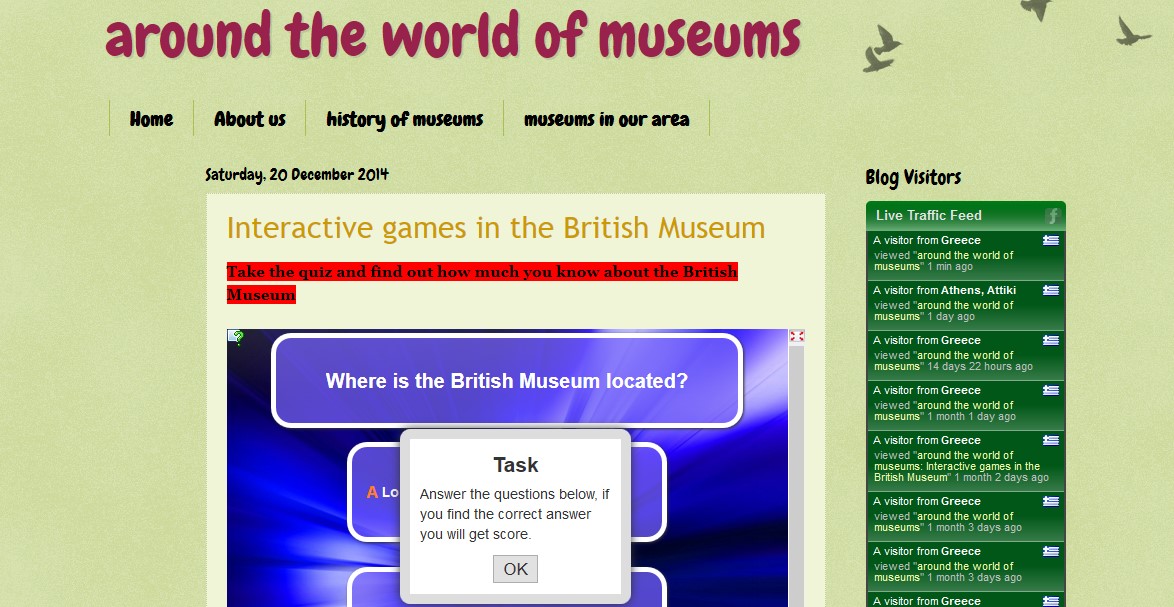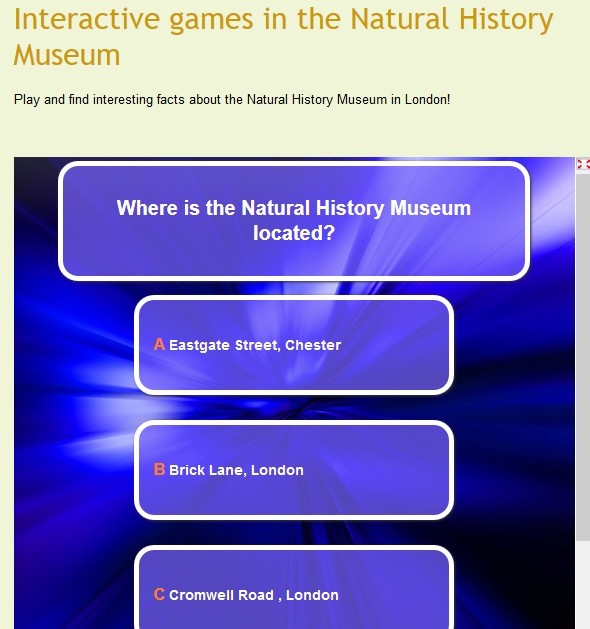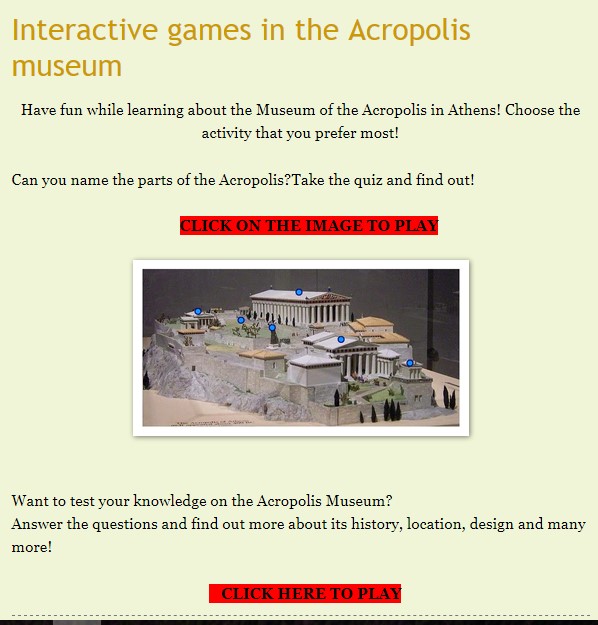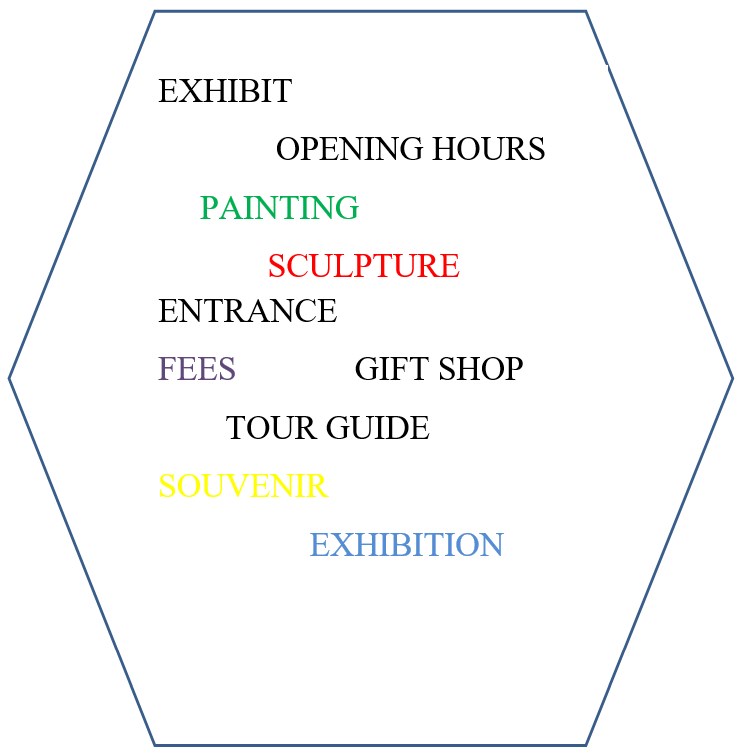Students Use Webtools and Create Interactive Games Based on Museums
Eleni Tsagari is a High School teacher of English on the island of Syros in the Cyclades, Greece. She has been teaching English for 13 years and she holds an MA in Applied Language Studies: Computing from the University of Kent at Canterbury. She is interested in the implementation of webtools in education. Currently, she is researching the use of art in education. She enjoys travelling, cooking and learning languages. Email: el_tsagari@yahoo.gr
Objectives
- To learn useful information about museums and exhibits around the world
- To become digitally literate
- To promote self-assessment and peer assessment
- To promote team building
Target group
My students are B2+ level. They attend senior high school and they are at the second grade (17 years old). They are interested in art and they want to learn more about museums of the world. Although they liked surfing the net about bizarre museums they finally decided to work on more well-known museums. They are interested in digital interactive games and thrilled to create their own stuff.
Time
WARM UP STAGE 45 minutes in class
WHILE STAGE 45 minutes in computer lab
FOLLOW UP STAGE 45 minutes in computer lab
A day before the class I post a word cloud on our e class platform with words (e.g. museums, exhibits, ancient,) and ask them to guess the topic to be taught.
The next day I hand out cartons in the various teams and ask them to expand on the topic by adding more words to the words I have posted the previous day. I usually use a circle and write the words to be added by students with colorful markers. Students are free to draw a word (add the drawing of a statue instead of just writing the word). (WORKSHEET 1-see Appendix)
In the while stage I let them work on a museum of their choice and hand out a second worksheet.(WORKSHEET 2- see Appendix) A list with museum resources is given to help them flip through museums of the world. We work in the ICT lab. It’s essential to let them choose a museum they like and also assign roles to ALL members of a group. Therefore, one of them should be the linguist (usually somebody who speaks English fluently), another one the ICT expert, a third one the secretary who should email me often and let me know about the team’s progress and a fourth one the archaeologist. I let them assign roles within a group. Working from home is also promoted since the 45 minutes should not be enough time to finish this activity. Students have managed to work using Skype as well. They fill in information for the museum of their choice and then about the exhibit they have chosen. In the second part the SEE- THINK-WONDER approach is chosen. What do you see (you describe the exhibit), what do you think about it (random thoughts) and finally what does it make you wonder.
Follow-up stage
A worksheet with guidelines on how to use a short list of web tools is given. It is important to allow them choose among a variety of tools according to their way of learning (visual, kinesthetic, verbal etc.). It is also crucial to create accounts for your students and share with them passwords and user names. They are not adults and issues with internet safety should be considered. The students used some web tools and created interactive quizzes based on the museums studied and also on some exhibits. For this project the following tools were chosen. The ICT teacher helped students during this class.
- Vocaroo (https://vocaroo.com/)- A voice recording service
- Learningapps (https://learningapps.org/)- A web 2.00 application offering various interactive modules
- Purposegames (https://www.purposegames.com/) An application to create interactive games
The interactive quizzes and games are uploaded on a blog created with the help of the teacher:http://aroundtheworldofmuseums.blogspot.gr/

Examples
EXAMPLE 1


EXAMPLE 2

EXAMPLE 3
A VOCAROO audio file
(https://vocaroo.com/player.swf?playMediaID=s1jMbtsNiNhu&autoplay=0
Conclusions
Using creativity in the EFL classroom is essential and inspiring not only for our students but also for us teachers. We need to deviate from the syllabus and let the learning process thrive!

Resources
http://www.moma.org/explore/collection/index (retrieved on 28/10/2017)
http://www.britishmuseum.org/ (retrieved on 28/10/2017)
Vocaroo (https://vocaroo.com/) (retrieved on 28/10/2017)
Learningapps (https://learningapps.org/) (retrieved on 28/10/2017)
Purposegames (https://www.purposegames.com/ (retrieved on 28/10/2017)
Appendix
WORKSHEET 1
WORKSHEET 2 -WHILE- STAGE ACTIVITIES
Work in groups of four and assign the following roles:
- The linguist(checks the use of English in the project)
- The ICT expert (studies the web tools to be used )
- the secretary (sends emails to the teacher regarding the team’s progress)
- the archaeologist ( studies the museum artefact to be used)
Fill in the information about the museum of your choice.
| NAME OF THE MUSEUM | ||
| LOCATION OF THE MUSEUM | ||
| MUSEUM BUILDING IMAGES | ||
| MUSEUM ACCESS (by car, metro….) | ||
| YEAR THE MUSEUM WAS BUILT | ||
|
FEES FOR
|
||
| EDUCATIONAL ACTIVITIES/GAMES AVAILABLE FOR KIDS AND TEENAGERS | YES | NO |
Choose an exhibit and fill in the information
| ΝΑΜΕ | |
|
TYPE OF EXHIBIT (PAINTING, SCULPTURE ETC) |
|
|
IMAGE OF THE EXHIBIT |
|
|
SHORT DESCRIPTION |
|
|
WHAT DO YOU THINK ABOUT IT |
|
|
WHAT DO YOU WONDER ABOUT IT |
Please check the Methodology and Language for Secondary course at Pilgrims website.
Please check the CLIL for Secondary course at Pilgrims website.
Please check the Practical uses of Technology in the English Classroom course at Pilgrims website.
Please check the Practical uses of Mobile Technology in the English Classroom course at Pilgrims website.
Creativity with IT: Using Edpuzzle
Martin Cooke, UK and TaiwanStudents Use Webtools and Create Interactive Games Based on Museums
Eleni Tsagari, Greece